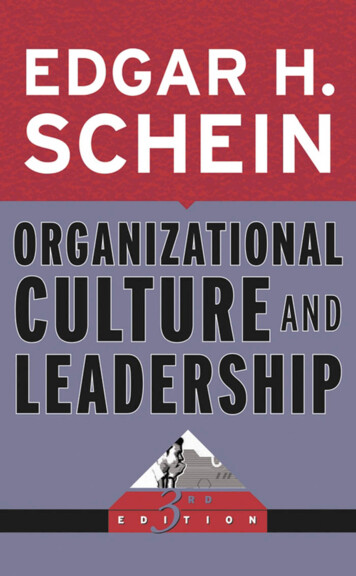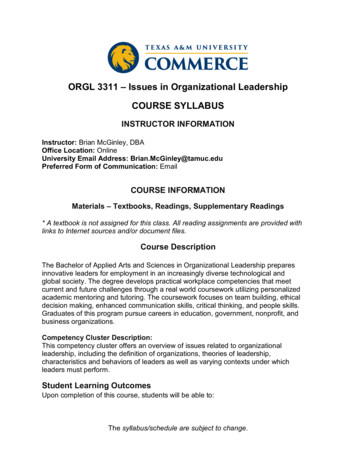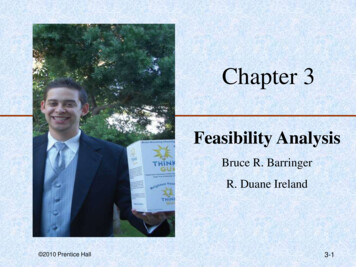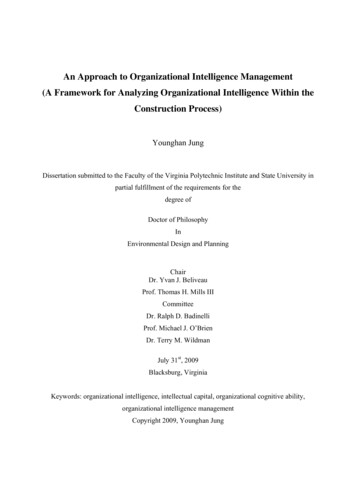
Transcription
OrganizationalCulture andLeadershipThird Edition
Organizational Cultureand Leadership
Edgar H. Schein
OrganizationalCulture andLeadershipThird Edition
Copyright 2004 by John Wiley & Sons, Inc. All rights reserved.Published by Jossey-BassA Wiley Imprint989 Market Street, San Francisco, CA 94103-1741www.josseybass.comNo part of this publication may be reproduced, stored in a retrieval system, or transmittedin any form or by any means, electronic, mechanical, photocopying, recording, scanning,or otherwise, except as permitted under Section 107 or 108 of the 1976 United StatesCopyright Act, without either the prior written permission of the Publisher, or authorizationthrough payment of the appropriate per-copy fee to the Copyright Clearance Center, Inc.,222 Rosewood Drive, Danvers, MA 01923, 978-750-8400, fax 978-750-4470, or on the webat www.copyright.com. Requests to the Publisher for permission should be addressed to thePermissions Department, John Wiley & Sons, Inc., 111 River Street, Hoboken, NJ 07030,201-748-6011, fax 201-748-6008, e-mail: permcoordinator@wiley.com.Jossey-Bass books and products are available through most bookstores. To contact Jossey-Bassdirectly call our Customer Care Department within the U.S. at 800-956-7739, outside theU.S. at 317-572-3986 or fax 317-572-4002.Jossey-Bass also publishes its books in a variety of electronic formats. Some content thatappears in print may not be available in electronic books.Library of Congress Cataloging-in-Publication DataSchein, Edgar H.Organizational culture and leadership / Edgar H. Schein.—3rd ed.p. cm.—(The Jossey-Bass business & management series)Includes bibliographical references and index.ISBN 0-7879-6845-5 (alk. paper)1. Corporate culture. 2. Culture. 3. Leadership. I. Title. II. Series.HD58.7.S33 2004302.3'5—dc222004002764Printed in the United States of AmericaTHIRD EDITIONHB Printing10 9 8 7 6 5 4 3 2 1
The Jossey-BassBusiness & Management Series
ContentsPrefacexiThe AuthorxvPart One: Organizational Cultureand Leadership Defined1. The Concept of Organizational Culture: Why Bother?132. The Levels of Culture253. Cultures in Organizations: Two Case Examples394. How Culture Emerges in New Groups63Part Two: The Dimensions of Culture5. Assumptions About External Adaptation Issues85876. Assumptions About Managing Internal Integration1117. Deeper Cultural Assumptions About Realityand Truth1378. Assumptions About the Nature of Time and Space1519. Assumptions About Human Nature, Activity,and Relationships17110. Cultural Typologies18911. Deciphering Culture203ix
xCONTENTSPart Three: The Leadership Role in Culture Building,Embedding, and Evolving22312. How Leaders Begin Culture Creation22513. How Leaders Embed and Transmit Culture24514. The Changing Role of Leadership in Organizational“Midlife”27315. What Leaders Need to Know About HowCulture Changes29116. A Conceptual Model for Managed Culture Change31917. Assessing Cultural Dimensions: A Ten-StepIntervention33718. A Case of Organizational (Cultural?) Change36519. The Learning Culture and the Learning Leader393References419Index429
PrefaceOrganizational culture has come of age. Not only did the concepthave staying power but it is even being broadened to occupationalcultures and community cultures. Culture at the national level ismore important than ever in helping us to understand intergroupconflict. As it turns out, culture is essential to understanding intergroup conflict at the organizational level as well. My years of consulting experience with Digital Equipment Corporation (DEC)provided useful case material (as the Action Company) in my previous editions, but it was only through my attempt to fully understand why DEC initially succeeded—and, in the end, failed as abusiness—that I came to realize the true importance of organizational culture as an explanatory concept. What happens in organizations is fairly easy to observe; for example, leadership failures,marketing myopia, arrogance based on past success, and so on; butin the effort to understand why such things happen, culture as aconcept comes into its own (Schein, 2003).In an age in which leadership is touted over and over again as acritical variable in defining the success or failure of organizations, itbecomes all the more important to look at the other side of the leadership coin—how leaders create culture and how culture defines andcreates leaders. The first and second editions of this book attemptedto show this connection, and I hope that I have been able tostrengthen the connection even more in this third edition.The conceptual models of how to think about the structure andfunctioning of organizational culture, and the role that leadershipplays in the creation and management of culture have remainedxi
xiiP R E FA C Emore or less the same in this third edition. However, I have beenable to add material based on more recent clinical research and tomake the concepts more vivid by identifying more of the organizations with whom I have worked over the years.All of the chapters have been redone and edited. Some havebeen shortened; more have been lengthened with additional casematerial that I was able to incorporate. In addition, I have selectively incorporated relevant material from a great many other booksand papers that have been written about organizational culturesince the last edition. It is clear that there are still different modelsavailable to scholars and practitioners on how to think about culture. I have not reviewed all of them in detail but have tried toshow, wherever possible, variations in point of view. I apologize tothose colleagues whose work I may have overlooked or chosen notto include, but my purpose is not to write the definitive textbook onculture; rather, it is to explore a way of thinking about culture thatI believe best suits our efforts to understand groups, organizations,and occupations.This edition is organized into three parts. Part One focuses onorganizational and occupational cultures—how to think aboutthem, how to define them, and how to analyze them. Leadershipis referred to throughout and leadership issues are highlighted,but the focus is clearly on getting a better feel for what culture isand does.Part Two focuses on the content of culture. In a sense, culturecovers all of a given group’s life; hence the content is, in principle,endless and vast. Yet we need categories for analysis, and here wecan draw on anthropology and group dynamics to develop a set ofdimensions that are most likely to be useful in making some conceptual sense of the cultural landscape as applied to organizations.In Part Three the focus shifts to the leader as founder, manager,and, ultimately, a victim of culture if the leader does not understandhow to manage culture. A crucial element in this analysis is tounderstand how culture coevolves with the organization as success
P R E FA C Exiiibrings growth and aging. The issues that leaders face at each ofthese different organizational growth stages are completely different, partly because the role that culture plays at each stage is completely different. This aspect of leadership is almost completelyignored in most leadership books.AcknowledgmentsMy most profound gratitude is to the readers of the first and secondedition. Were it not for their positive and critical feedback, andtheir use of this book in their courses and their consulting work, Iwould not have had the energy to write a third edition. Support andstimulation from colleagues again played a key role, especially thefeedback from John Van Maanen, Otto Scharmer, Joanne Martin,Mary Jo Hatch, Majken Schultz, and Peter Frost.The publisher, Jossey-Bass, has always been totally encouragingand their editorial staff, especially Byron Schneider, urged me onrelentlessly but in a positive and supportive way. The reviews theyprovided were essential to gaining perspective on a book that wasfirst published in 1985. I got many good ideas about what was working and should be preserved, what needed to be cut out, and whatneeded to be added or enhanced. I thank each of them.I think it is also important to acknowledge the tremendous positive impact of word processing technology. Work on this editionwas launched with a set of chapters scanned in from the second edition, permitting immediate on-line editing. Material from the firstedition that I decided to bring back in the third edition could bescanned and immediately incorporated where it belonged. Feedback from readers could be incorporated into the text directly andused or not used, without additional retyping. Final copy could besent to the publisher directly on discs or electronically. Once errorswere corrected they stayed corrected. All of this is a most unusualand pleasant experience for an author who can remember whatwriting was like with carbons, ditto paper, and endless retyping.
xivP R E FA C ELast but not least I thank my wife, Mary, for sitting by patientlywhile I disappeared to work at the computer from time to time. Butshe too has gotten hooked on the power of e-mail and other electronic marvels, so she is now more understanding of how screenscapture our attention.May 2004Cambridge, MassachusettsEdgar H. Schein
The AuthorEdgar H. Schein was educated at the University of Chicago; atStanford University, where he received a master’s degree in psychology in 1949; and at Harvard University, where he received hisPh.D. in social psychology in 1952. He was chief of the Social Psychology Section of the Walter Reed Army Institute of Researchwhile serving in the U.S. Army as a captain from 1952 to 1956. Hejoined the Sloan School of Management at the Massachusetts Institute of Technology (MIT) in 1956 and was made a professor oforganizational psychology and management in 1964.From 1968 to 1971 Schein was the undergraduate planningprofessor for MIT, and in 1972 he became the chairman of theOrganization Studies Group at the Sloan School, a position heheld until 1982. He was honored in 1978 when he was named theSloan Fellows Professor of Management, a chair he held until 1990.At present he is Sloan Fellows Professor of Management Emeritus and continues at the Sloan School part time as a senior lecturer. He is also the founding editor of Reflections, the journal ofthe Society for Organizational Learning, which is devoted to connecting academics, consultants, and practitioners around the issuesof knowledge creation, dissemination, and utilization.Schein has been a prolific researcher, writer, teacher, and consultant. Besides his numerous articles in professional journals, hehas authored fourteen books, including Organizational Psychology(third edition, 1980), Career Dynamics (1978), Organizational Culture and Leadership (1985, 1992), Process Consultation Vol. 1 and Vol. 2xv
xviTHE AUTHOR(1969, 1987, 1988), Process Consultation Revisited (1999), and TheCorporate Culture Survival Guide (1999).Schein wrote a cultural analysis of the Singapore EconomicDevelopment Board, entitled Strategic Pragmatism (MIT Press, 1997),and he has published an extended case analysis of the rise and fall ofDigital Equipment Corporation, entitled DEC Is Dead; Long LiveDEC: The Lasting Legacy of Digital Equipment Corporation (BerrettKoehler, 2003). He was coeditor with the late Richard Beckhard ofthe Addison Wesley Series on Organization Development, which haspublished over thirty titles since its inception in 1969.His consultation focuses on organizational culture, organizationdevelopment, process consultation, and career dynamics; among hispast and current clients are major corporations both in the U.S. andoverseas, such as Digital Equipment Corporation (DEC), CibaGeigy, Apple, Citibank, General Foods, Procter & Gamble, Imperial Chemical Industries (ICI), Saab Combitech, Steinbergs, Alcoa,Motorola, Hewlett-Packard, Exxon, Shell, Amoco, Con Edison,the Economic Development Board of Singapore, and the International Atomic Energy Agency (on the subject of “safety culture”).Schein has received many honors and awards for his writing,most recently the Lifetime Achievement Award in Workplace Learning and Performance of the American Society of Training Directors, February 3, 2000; the Everett Cherrington Hughes Award forCareer Scholarship from the Careers Division of the Academy ofManagement, August 8, 2000; and the Marion Gislason Award forLeadership in Executive Development from the Boston UniversitySchool of Management Executive Development Roundtable,December 11, 2002.He is a Fellow of the American Psychological Association andthe Academy of Management. Schein is married and has three children and seven grandchildren. He and his wife, Mary, live in Cambridge, Massachusetts.
Organizational Cultureand Leadership
Part OneORGANIZATIONALCULTURE ANDLEADERSHIP DEFINEDIn this section of the book I will define the concept of culture andshow its relationship to leadership. Culture is both a dynamic phenomenon that surrounds us at all times, being constantly enactedand created by our interactions with others and shaped by leadership behavior, and a set of structures, routines, rules, and norms thatguide and constrain behavior. When one brings culture to the levelof the organization and even down to groups within the organization, one can see clearly how culture is created, embedded, evolved,and ultimately manipulated, and, at the same time, how cultureconstrains, stabilizes, and provides structure and meaning to thegroup members. These dynamic processes of culture creation andmanagement are the essence of leadership and make one realizethat leadership and culture are two sides of the same coin.Leadership has been studied in far greater detail than organizational culture, leading to a frustrating diffusion of concepts andideas of what leadership is really all about, whether one is born or1
2O R G A N I Z AT I O N A L C U LT U R E A N D L E A D E R S H I Pmade as a leader, whether one can train people to be leaders, andwhat characteristics successful leaders possess. I will not review thisliterature, focusing instead on what I consider to be uniquely associated with leadership—the creation and management of culture.As we will see, this requires an evolutionary perspective. Ibelieve that cultures begin with leaders who impose their own values and assumptions on a group. If that group is successful and theassumptions come to be taken for granted, we then have a culturethat will define for later generations of members what kinds of leadership are acceptable. The culture now defines leadership. But asthe group runs into adaptive difficulties, as its environment changesto the point where some of its assumptions are no longer valid, leadership comes into play once more. Leadership is now the ability tostep outside the culture that created the leader and to start evolutionary change processes that are more adaptive. This ability to perceive the limitations of one’s own culture and to evolve the cultureadaptively is the essence and ultimate challenge of leadership.If leaders are to fulfill this challenge, they must first understandthe dynamics of culture, so our journey begins with a focus on definitions, case illustrations, and a suggested way of thinking aboutorganizational culture. In this part, I begin in Chapter One withsome brief illustrations and a definition. Chapter Two expands theconcept and argues for a multilevel conception of culture. In Chapter Three, I examine in some detail two cases that illustrate well thecomplexity of culture and will be used throughout the rest of thebook. And in Chapter Four, I show how culture arises in the processof human interaction.At this point, the most important message for leaders is this: “tryto understand culture, give it its due, and ask yourself how well youcan begin to understand the culture in which you are embedded.In Part Two of this book we turn to the content of culture, andin Part Three, to the dynamic processes involved in the interactionof leadership and culture.
1THE CONCEPT OFO R G A N I Z AT I O N A L C U LT U R E :WHY BOTHER?Culture is an abstraction, yet the forces that are created in socialand organizational situations that derive from culture are powerful.If we don’t understand the operation of these forces, we become victim to them. To illustrate how the concept of culture helps to illuminate organizational situations, I will begin by describing severalsituations I have encountered in my experience as a consultant.Four Brief ExamplesIn the first case, that of Digital Equipment Corporation (DEC), Iwas called in to help a management group improve its communication, interpersonal relationships, and decision making. After sittingin on a number of meetings, I observed, among other things, (1)high levels of interrupting, confrontation, and debate; (2) excessive emotionality about proposed courses of action; (3) great frustration over the difficulty of getting a point of view across; and (4)a sense that every member of the group wanted to win all the time.Over a period of several months, I made many suggestions aboutbetter listening, less interrupting, more orderly processing of theagenda, the potential negative effects of high emotionality and conflict, and the need to reduce the frustration level. The group members said that the suggestions were helpful, and they modified certainaspects of their procedure; for example, they scheduled more time forsome of their meetings. However, the basic pattern did not change.No matter what kind of intervention I attempted, the basic style ofthe group remained the same.3
4O R G A N I Z AT I O N A L C U LT U R E A N D L E A D E R S H I PIn the second case, that of the Ciba-Geigy Company—a largemultinational chemical and pharmaceutical company located inBasel, Switzerland—I was asked, as part of a broader consultationproject, to help create a climate for innovation in an organizationthat felt a need to become more flexible in order to respond to itsincreasingly dynamic business environment. The organization consisted of many different business units, geographical units, and functional groups. As I got to know more about these units and theirproblems, I observed that some very innovative things were goingon in many places in the company. I wrote several memos thatdescribed these innovations and presented other ideas from my ownexperience. I gave the memos to my contact person in the companywith the request that he distribute them to the various geographicand business unit managers who needed to be made aware of theseideas.After some months, I discovered that those managers to whomI had personally given the memo thought it was helpful and on target, but rarely, if ever, did they pass it on, and none were ever distributed by my contact person. I also suggested meetings of managersfrom different units to stimulate lateral communication, but foundno support at all for such meetings. No matter what I did, I could notseem to get information flowing, especially laterally across divisional,functional, or geographical boundaries. Yet everyone agreed in principle that innovation would be stimulated by more lateral communication and encouraged me to keep on “helping.”In the third example, Amoco, a large oil company that waseventually merged with British Petroleum (BP), decided to centralize all of its engineering functions in a single service unit.Whereas engineers had previously been regular parts of projects,they were now supposed to sell their services to clients who wouldbe charged for these services. The engineers resisted violently andmany of them threatened to leave the organization. We wereunable to reorganize this engineering organization to fit the newcompany requirements.
T H E C O N C E P T O F O R G A N I Z AT I O N A L C U LT U R E5In the fourth example, Alpha Power, an electric and gas utilitythat services a large urban area, was faced with having to becomemore environmentally responsible after the company was broughtup on criminal charges for allegedly failing to report the presence ofasbestos in a local unit that had suffered an accident. Electricalworkers, who took pride in their “heroic” self-image of keeping thelights on no matter what, also held the strong norm that one didnot report spills and other environmental and safety problems ifsuch reports would embarrass the group. I was involved in a multiyear project to change this self-image to one in which the “heroic”model would be to report all safety and environmental hazards,even if that meant reporting on peers—or bosses. All employeeswere supposed to adopt a new concept of personal responsibility,teamwork, and openness of communication. Yet no matter howclear the new mandate was made, safety problems continued wherever peer group relations were involved.I did not really understand the forces operating in any of thesecases until I began to examine my own assumptions about howthings should work in these organizations and began to test whethermy assumptions fitted those operating in my clients’ systems. Thisstep—examining the shared assumptions in the organization orgroup one is dealing with and comparing them to one’s own—takesone into cultural analysis and will be the focus from here on.It turned out that at DEC, an assumption was shared by seniormanagers and most of the other members of the organization: thatone cannot determine whether or not something is “true” or “valid”unless one subjects the idea or proposal to intensive debate; and further, that only ideas that survive such debate are worth acting on,and only ideas that survive such scrutiny will be implemented. Thegroup assumed that what they were doing was discovering truth,and in this context being polite to each other was relatively unimportant. I became more helpful to the group when I realized thisand went to the flip chart and just started to write down the variousideas they were processing. If someone was interrupted, I could ask
6O R G A N I Z AT I O N A L C U LT U R E A N D L E A D E R S H I Pthem to restate their point instead of punishing the interrupter. Thegroup began to focus on the items on the chart and found that thisreally did help their communication and decision process. I hadfinally understood and entered into an essential element of their culture instead of imposing my own.At Ciba-Geigy I eventually discovered that there was a strongshared assumption that each manager’s job was his or her private“turf,” not to be infringed on. The strong impression was communicated that one’s job is like one’s home, and if someone gives oneunsolicited information, it is like walking into one’s home uninvited. Sending memos to people implies that they do not alreadyknow what is in the memo, and that is potentially insulting. In thisorganization managers prided themselves on knowing whateverthey needed to know to do their job. Had I understood this, I wouldhave asked for a list of the names of the managers and sent thememo directly to them. They would have accepted it from mebecause I was the paid consultant and expert.At Amoco I began to understand the resistance of the engineerswhen I learned that in their occupational culture there are strongassumptions that “good work should speak for itself” and “engineersshould not have to go out and sell themselves.” They were used tohaving people come to them for services and did not have a goodrole model for how to sell themselves.At Alpha Power I learned that all work units had strong normsand values of self-protection that often overrode the new requirements imposed on the company by the courts. The groups had theirown experience base for what was safe and what was not, whichthey were willing to trust, whereas the tasks of reporting environmental spills and cleaning them up involved new skills that workers were eventually willing to learn and collaborate on.In each of these cases I initially did not understand what wasgoing on because my own basic assumptions about truth and turfand group relations differed from the shared assumptions of themembers of the organization. And my assumptions reflected myoccupation as a social psychologist and organization consultant,
T H E C O N C E P T O F O R G A N I Z AT I O N A L C U LT U R E7while the group’s assumptions reflected in part their occupations aselectrical engineers, chemists, and electrical workers.To make sense of such situations requires taking a cultural perspective; learning to see the world through cultural lenses; becoming competent in cultural analysis—by which I mean being able toperceive and decipher the cultural forces that operate in groups,organizations, and occupations. Once we learn to see the worldthrough cultural lenses, all kinds of things begin to make sense thatinitially were mysterious, frustrating, or seemingly stupid.Culture: An Empirically Based AbstractionCulture as a concept has had a long and checkered history. It hasbeen used by the layman as a word to indicate sophistication, aswhen we say that someone is very “cultured.” It has been used byanthropologists to refer to the customs and rituals that societiesdevelop over the course of their history. In the last several decadesit has been used by some organizational researchers and managersto refer to the climate and practices that organizations developaround their handling of people, or to the espoused values andcredo of an organization.In this context, managers speak of developing the “right kind ofculture,” a “culture of quality” or a “culture of customer service,”suggesting that culture has to do with certain values that managersare trying to inculcate in their organizations. Also implied in thisusage is the assumption that there are better or worse cultures andstronger or weaker cultures, and that the “right” kind of culture willinfluence how effective the organization is. In the managerial literature there is often the implication that having a culture is necessary for effective performance, and that the stronger the culture, themore effective the organization.Researchers have supported some of these views by reportingfindings that cultural “strength” or certain kinds of cultures correlate with economic performance (Denison, 1990; Kotter andHeskett, 1992; Sorensen, 2002). Consultants have touted “culture
8O R G A N I Z AT I O N A L C U LT U R E A N D L E A D E R S H I Psurveys” and have claimed that they can improve organizationalperformance by helping organizations create certain kinds of cultures, but these claims are based on very different definitions of culture than what I will be arguing for here. As we will see, many ofthese usages of the word culture display not only a superficial andincorrect view of culture, but also a dangerous tendency to evaluate particular cultures in an absolute way and to suggest that thereactually are “right” cultures for organizations. As we will also see,whether or not a culture is “good” or “bad,” “functionally effective”or not, depends not on the culture alone, but on the relationshipof the culture to the environment in which it exists.Perhaps the most intriguing aspect of culture as a concept isthat it points us to phenomena that are below the surface, that arepowerful in their impact but invisible and to a considerable degreeunconscious. In that sense, culture is to a group what personality orcharacter is to an individual. We can see the behavior that results,but often we cannot see the forces underneath that cause certainkinds of behavior. Yet, just as our personality and character guideand constrain our behavior, so does culture guide and constrain thebehavior of members of a group through the shared norms that areheld in that group.To complicate matters further, one can view personality andcharacter as the accumulation of cultural learning that an individual has experienced in the family, the peer group, the school, thecommunity, and the occupation. In this sense, culture is within usas individuals and yet constantly evolving as we join and create newgroups that eventually create new cultures. Culture as a concept isthus an abstraction but its behavioral and attitudinal consequencesare very concrete indeed.If an abstract concept is to be useful to our thinking, it shouldbe observable and also increase our understanding of a set of eventsthat are otherwise mysterious or not well understood. From thispoint of view, I will argue that we must avoid the superficial modelsof culture and build on the deeper, more complex anthropologicalmodels. Culture as a concept will be most useful if it helps us to bet-
T H E C O N C E P T O F O R G A N I Z AT I O N A L C U LT U R E9ter understand the hidden and complex aspects of life in groups,organizations, and occupations, and we cannot obtain this understanding if we use superficial definitions.What Needs to Be Explained?Most of us, in our roles as students, employees, managers, researchers, or consultants, work in and have to deal with groups and organizations of all kinds. Yet we continue to find it amazingly difficultto understand and justify much of what we observe and experiencein our organizational life. Too much seems to be bureaucratic orpolitical or just plain irrational—as in the four cases that I describedat the beginning of this chapter.People in positions of authority, especially our immediatebosses, often frustrate us or act incomprehensibly; those we considerthe leaders of our organizations often disappoint us. When we getinto arguments or negotiations with others, we often cannot understand how our opponents could take such ridiculous positions.When we observe other organizations, we often find it incomprehensible that smart people could do such dumb things. We recognize cultural differences at the ethnic or national level, but findthem puzzling at the group, organizational, or occupational level.As managers, when we try to change the behavior of subordinates, we often encounter resistance to change to an
Jossey-Bass also publishes its books in a variety of electronic formats. Some content that appears in print may not be available in electronic books. Library of Congress Cataloging-in-Publication Data Schein, Edgar H. Organizational culture and leadership / Edgar H. Schein.—3rd ed.










